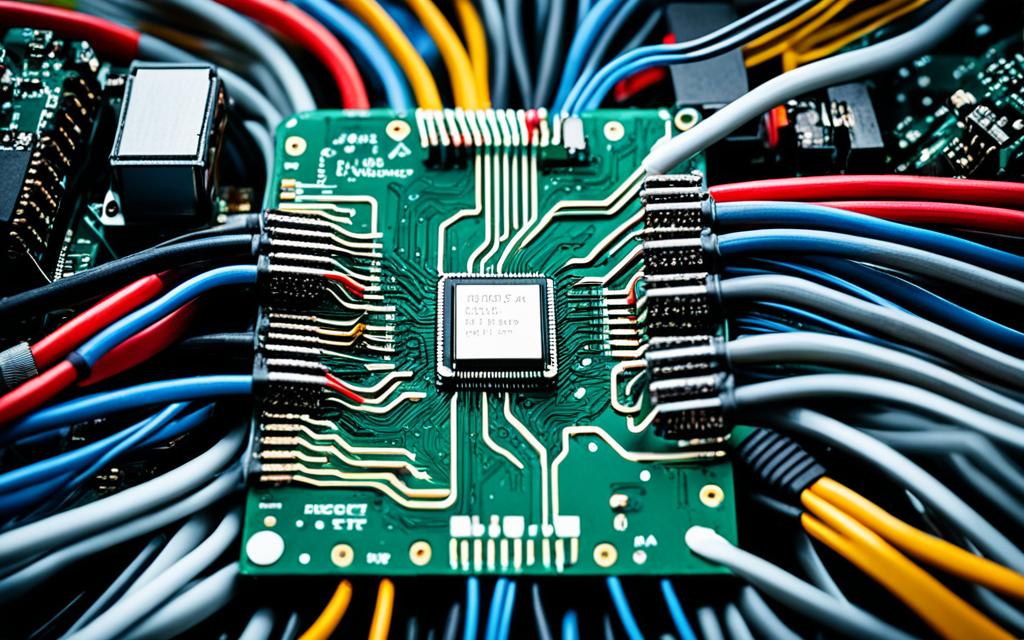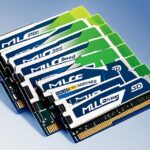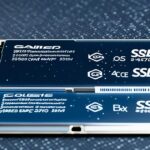Table of Contents
Solid State Drives (SSDs) are known for being quick and efficient compared to old hard drives. But, many users find their SSDs don’t perform as expected. It’s crucial to know why there’s a gap between expected and actual SSD speed to boost performance.
The speeds advertised are often the best possible, but real-life use shows a big difference. Issues with firmware can slow down many SSDs1. Not having enough space and too much fragmentation also play a role in making SSDs slower2. High temperatures can also reduce how fast SSDs read and write data.
To get the most out of your SSD, look into these issues. Making some changes, like updating drivers and making sure there’s enough storage, can help. These steps ensure your SSD works well for longer.
Key Takeaways
- SSDs can face performance issues due to various factors, including firmware problems.
- Understanding your SSD’s operating conditions is key for optimal functionality.
- Regularly monitoring storage space and fragmentation is essential to maintain speed.
- Keeping your SSD drivers and firmware updated can prevent slowdowns.
- Taking proactive steps can significantly improve your SSD performance.
Understanding SSD Speed Ratings
When we talk about SSD speed ratings, understanding what the numbers mean is key. These numbers usually show the best possible performance in perfect situations. However, everyday use doesn’t always match up. For instance, an SSD might say it can reach speeds of 550MB/s for reading and 520MB/s for writing. But in the real world, various factors can slow these speeds down3. Brands like SanDisk share this info so users know what to expect in real-life use4.
What Do Advertised Speeds Mean?
Advertised speeds are based on specific test conditions. These conditions often involve large, sequential data access. But, average users usually deal with smaller, random data transfers over 50% of the time3. This is why looking beyond just the highest speed numbers is important. It helps avoid misunderstandings about how fast the SSD will be for everyday tasks.
Peak Performance vs. Real-World Usage
Understanding the difference between peak performance and daily use is crucial. Even if SSDs boast high speeds, their performance can be limited by various factors in regular tasks. For example, in perfect scenarios, an SSD performs well. Yet, ordinary users will find that lower, more practical speeds matter more for their daily needs3. Performance differences can also be big. For instance, SSD access times can be as low as 0.01 to 0.02 milliseconds. This is much faster than traditional hard drives, which can be over 9 milliseconds3.
Factors Affecting SSD Performance
Understanding how an SSD works is key to making it run faster. Many items play a big role in the efficiency of solid-state drives. This involves the extra work from background tasks and how the operating system affects it.
Overhead from Background Processes
Background tasks can slow things down by using up important SSD resources. When several apps run at once, they share your computer’s memory and power. This can make your SSD slower. If your computer is scanning for viruses while opening files, you might notice it becomes sluggish.
Impact of Operating System Loading
The operating system has a big role in handling files and running the system. It can start tasks that slow down the SSD. For example, updates or backups can make things slower when you’re also moving data. SSDs are great for fast tasks like booting up and gaming. But problems like not enough disk space or firmware issues can reduce speed. It shows how important it is to keep everything up to date and running smoothly5.
| Factor | Description |
|---|---|
| Background Processes | Can slow down access speeds by consuming system resources. |
| Operating System Loading | Tasks within the OS can compete with SSD operations for resources. |
| Disk Space | Limited space can hinder performance, leading to slower speeds. |
| Firmware Issues | Outdated firmware can create significant performance bottlenecks. |
Improving these elements can enhance your SSD’s work and user experience. Knowing how background applications and the system’s tasks affect your SSD is crucial for top efficiency67.
Why Is My SSD Slower Than Advertised?
It can be very annoying when your SSD runs slower than you expected. Knowing why this happens can make the problem easier to understand. There are mainly two things to look at: the conditions under which SSD speeds are tested and the limitations of your device. The difference in performance might come from the way SSDs are tested versus how they are used day-to-day.
Differences in Test Conditions
Testing conditions for SSDs often set up a perfect scenario that doesn’t match everyday use. For instance, tests in controlled environments might show higher speeds than what you get at home. This is because those tests happen under conditions that don’t occur in normal computer setups. Also, testing with SATA III might show speeds up to 550MB/s. But older technology, like SATA II, can restrict a drive’s speed, leading to SSD performance issues that users don’t fully understand8.
Device Chain Limitations
An SSD’s speed greatly depends on the setup of the device chain. Many times, people don’t consider how old cables or poor connections can limit an SSD. For instance, NVMe SSDs with PCIe 4.0 can transfer data at speeds up to 64,000MB/s. However, many computer systems may only support slower speeds, which affects overall performance8. If SSDs are used with connections that don’t match, this can cause a big drop in speed. It shows a big difference between the performance you expect and what you actually get.
Capacity and Usable Space Discrepancies
It’s important to understand why the SSD space you see advertised isn’t always what you get. The way companies calculate capacity and the space taken up by the file system play big roles. Let’s dive into these differences and see why they happen.
Understanding Drive Capacity Calculation
When SSDs are marketed, the sizes are usually in gigabytes based on a decimal system. 1GB is counted as 1 billion bytes. But this makes the capacity appear bigger than it is. For example, a 120GB SSD often has just about 112GB of real space9. And an 80GB drive tends to give you about 74.5GB to use, losing around 7% of the space advertised10. It’s normal, but it can be annoying for users.
Impact of File System Overhead
File system overhead is another big reason your SSD might have less space than expected. To work, every file system needs some space of its own. This results in less free space. For instance, a 256GB SSD might only offer about 240GB for your use, due to how it’s managed and how space is reported10. This issue is more common with SSDs than traditional hard drives, which might be more consistent in space offered10. Knowing these details can help users make better choices about their storage solutions.
Optimising Your SSD for Better Performance
To get the best out of your SSD, it’s crucial to follow some smart steps. You’ll need to manage background tasks well and handle temporary files with care.
Disabling Unnecessary Background Tasks
Turning off tasks you don’t need can really help. This includes stopping automatic updates and closing apps that use lots of resources. Windows 11 even has a feature that suggests when to do maintenance to keep your SSD running smoothly11.
Managing Temporary and Paging Files
Handling temporary files and page files right is key for keeping your SSD fast. Moving these to a normal hard drive helps avoid too much wear and tear. Also, turning off SSD indexing can make your drive last longer12.
Changing power settings can also make a difference in performance. It helps keep your data safe and prevents errors12.
By keeping things tidy and managing your SSD’s resources smartly, you encourage a fast and reliable computer. This helps everyone looking to make their SSDs perform at their best.
Troubleshooting Slow SSD Issues
When you find your SSD running slowly, there are a few key areas to check. It’s crucial to use the right connection types and high-quality cables. This can make your drive work much better. Using SATA III connections instead of SATA II can make a big difference, especially with older SSDs. If your SSD is nearly full, it could slow down, affecting how well your computer works2.
Checking Connection Types and Cables
It’s a good idea to regularly check the connection types and cables for your SSD. Choose SATA cables from trusted brands to ensure better performance. Low-quality cables can reduce data transfer rates, making your system sluggish. Also, connecting your SSD to the fastest SATA port can boost its speed. This is because not all ports on a motherboard work at the same speed13.
BIOS Settings and Their Impact
The settings in your BIOS play a big part in how well your SSD performs. Make sure the BIOS properly recognizes your SSD. If settings like AHCI mode are off, or the boot order is wrong, you’ll likely see performance drops. Turning on AHCI mode improves how your SSD reads and writes data, and helps it handle problems better. It’s also important to keep your BIOS updated. Updates can improve how well your SSD and computer work together14
Conclusion
Understanding SSD performance is very important for users wanting to get the most out of their drives. There are many things that can affect how fast an SSD works. This includes how they’re advertised, different testing conditions, and other factors that might slow them down. Users can improve their SSD’s speed by managing background tasks and setting up their hardware correctly.
Knowing the limits of SSDs also helps users make better use of them. For example, turning on TRIM support is crucial for them to work well, as shown in our references. Keeping everything up-to-date, like drivers, helps stop the SSD from getting slower over time. This care can make the SSD work better and last longer with proper care.
To really benefit from an SSD, users need to look out for and fix any issues themselves. They should also follow best practices. This way, they can close the gap between the speeds they expect and what they actually get. This leads to a better and more skilled use of SSD technology15216.
FAQ
Why is my SSD not performing as advertised?
SSD performance might not meet expectations due to many factors. These include background process overload, the effect of operating system tasks, and real-world usage differing from test conditions.
What do advertised speeds mean for SSDs?
Manufacturers test SSDs under ideal conditions to find the peak speeds. However, regular use might show lower speeds. This happens as system resources are shared and background tasks impact performance.
How do background processes affect SSD speeds?
Background tasks can slow down your SSD by using up system resources. This leads to higher latency and slower response times, making your SSD feel sluggish.
Are there specific factors that can influence SSD performance?
Certain things can change how well your SSD works. The type of cables, connection interface (SATA III vs. SATA II), and BIOS settings all play a role.
What causes the difference between advertised and actual usable space on my SSD?
The way manufacturers and operating systems calculate storage capacity is different. File system tasks also take up some space, reducing the SSD’s usable storage.
How can I optimise my SSD for better performance?
To boost SSD performance, turn off unnecessary background applications. Also, manage paging files wisely and tune your system settings for optimal SSD use.
What should I check when troubleshooting slow SSD issues?
Review your SSD’s connections and cables first. Then, look at BIOS settings to make sure the SSD is set up properly for the best performance.
Source Links
- https://rog-forum.asus.com/t5/hardware-build-advice/why-is-my-970-evo-plus-ssd-slower-than-it-s-supposed-to-be/td-p/816543 – Why is my 970 Evo Plus SSD slower than it’s supposed to be?
- https://www.easeus.com/computer-instruction/ssd-slow-write-speed.html – How to Fix SSD Slow Write Speed on Windows 10/11 [Full Guide]
- https://www.thessdreview.com/ssd-guides/beginners-guide/the-ssd-manufacturers-bluff/2/ – Understanding SSD Advertised Performance and Its Purchase Implications – An SSD Primer – The SSD Review
- https://www.techradar.com/features/do-ps5-ssd-read-and-write-speeds-really-make-a-difference – Do PS5 SSD read and write speeds really make a difference?
- https://www.minitool.com/backup-tips/sandisk-ssd-slow.html – Why Is SanDisk SSD Slow? How to Fix Slow Read & Write Speed? – MiniTool
- https://www.lacie.com/support/kb/Why-cant-I-reach-the-advertised-performance-of-my-external-drive/ – Why can’t I reach the advertised performance of my external drive? | LaCie Support US
- https://www.diskpart.com/articles/how-to-maximize-SSD-transfer-speed-0725.html – How to Maximize SSD Transfer Speed
- https://www.kingston.com/en/blog/pc-performance/benefits-of-ssd – The 5 Benefits of SSDs over Hard Drives- Kingston Technology
- https://www.diskpart.com/articles/ssd-reports-wrong-size-7201.html – SSD Reports Wrong Size in Windows? Why and How to Fix it Easily!
- https://www.lifewire.com/drive-storage-capacities-833435 – Why Does My Hard Drive Store Less Than Its Capacity?
- https://www.tomshardware.com/how-to/optimize-ssd-in-windows – How to Optimize SSD Performance in Windows 10 or 11
- https://www.crucial.com/support/articles-faq-ssd/optimizing-your-ssd – Optimizing Your SSD
- https://www.clonefileschecker.com/blog/how-to-fix-slow-ssd-performance-in-windows-10/ – How to Fix Slow SSD Performance in Windows 10 |
- https://www.crucial.com/support/articles-faq-ssd/ssd-used-to-be-faster-but-has-slowed-down – My SSD Used To Be So Much Faster But Has Recently Slowed Down … What Happened?
- https://www.pchardwarehelp.com/guides/optimize-ssd-windows.php – How to Optimize SSD for Faster Performance (Windows Tweaks)
- https://www.bittware.com/resources/ssd-write-performance/ – NVMe SSD Write Performance White Paper








